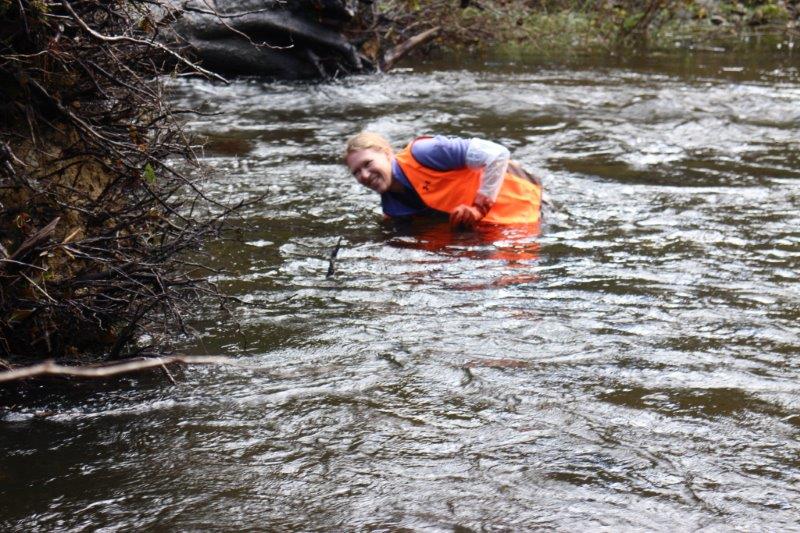New research identifies how forest conditions interact with snowpack in the Cascades Mountain range in Washington State. Focused on the drier eastern slopes, this research informs forest restoration strategies that both protect water supplies and reduce wildfire risk.
A Mid-October Swim in Hurst and Shale Creeks
Written and Photographed by Emily Howe, Conservancy Aquatic Ecologist
The trouble with field biology is that every once in a while, your best laid experimental designs are obliterated by a typhoon.
Such was the case last week, when Typhoon Songda blasted across the Pacific and slammed into the Washington coast. Puget Sound was spared the brunt of the winds, as the storm was compact and tracked 60 miles further northwest than expected. The coast, however, was spared nothing in terms of rain and wind, clocking in 78 mph gusts and 3" of rain in a 24 hr period.
Now, I'd carefully planned to retrieve all my stream temperature loggers from Hurst and Shale creeks on Thursday and Friday, October 13th and 14th. By Tuesday, we knew of a weather system coming for the end of the week. By Wednesday, Cliff Mass was forecasting a mega-storm. We watched the storm track, the rain forecasts, and wind forecasts. We watched the low pressure depression, and the storm size. We translated wind speed to tree strengths. And we tried to translate rainfall to river height. That's tricky for a system that doesn't have a gauge on it.
In the end, we cancelled.
We crossed our fingers that the loggers would hold through the storm, waited a few days for a break in the weather, and headed west to the Clearwater Basin near Kalaloch.
I took my sister as my intrepid volunteer. She worked in the ONP for years revegetating high alpine meadows and living out of her tent in the drenching rain. She's a well vetted bushwhacker with the highest of credentials.
We arrived at Hurst Creek to find the downstream reach below our 6 log jams roaring. The river was only knee-deep, but was so swift that I could barely stand. That first logger was long gone, probably taking temps in the Pacific Ocean by now.
The river stretches between the log jams were deep, slow moving pools. I could safely wade out to my ribcage without losing my footing. The only problem was that my loggers were anchored to the creek bed and my arms are not 4 feet long. But, I'm a water person, and getting wet is par for the course. If I laid my face on the water, and submerged my neck and shoulder, I could just barely reach the loggers.
The upper jam on Hurst is an incredible sight. We knew last summer that it was doing its job to trap sediment and rebuild the stream bed in an intensely downcut section of the creek, but what we didn't see last summer was the immense collection of leaf litter that it also traps. Right now, there are literally two islands in the creek built entirely of leaves and twigs. They are about 20 ft long, 5 feet wide, and 3 ft thick. If you stand on them, you sink up to your knees in leaves. This is nutrient storage in action. This is how streams hang on to energy at the base of the food web. This is how productivity is conserved in flowing waters.
In the end, we retrieved 6 of 11 loggers on Hurst, and only 1 of 4 on Shale. The storm beat me by a day, but the fish welcomed the pulse of freshwater. Indeed, we watched the first scouts nose their way up Shale, easily passing through a tangle of natural log jams on their way.
Introducing Emily Howe
Written by Tammy Kennon
Photographed by Hannah Letinich, Volunteer Photo Editor
Emily Howe remembers a time when there were so many salmon, “they would bump your ankles. You could pet them!”
Emily, the Washington Nature Conservancy’s newest staff member, saw those fin-to-fin salmon as a child while camping with her family at Lake Wenatchee on the east side of the Cascades. But over the years as her family returned to the same stream, she watched those salmon dwindle, a firsthand observation of how humans impact the environment that launched a career.
After completing a biology degree at Vermont’s Middlebury College, she continued her education at the University of Washington, Seattle, earning an M.S. and a Ph.D. in Aquatic and Fishery Science.
To add real life experience to her education, Emily studied abroad in the San Blas Islands, off the Caribbean coast of Panama, and in Tanzania, an opportunity to “further how we think about land and people.”
“You can’t leave the people out; you have to integrate them,” Emily says. “We’re trying to figure out how to transform our daily lives to include nature, to offer natural solutions. We don’t have to have a negative impact. It can positive.”
In her new role as Aquatic Ecologist, Emily has come full circle. She will focus on salmon recovery, measuring the success of Nature Conservancy land and freshwater restoration efforts.
“We’re trying to get back to a system that works and functions more naturally,” Emily says. “Sometimes that’s building something that works like nature does.”
The Nature Conservancy efforts include rebuilding logjams to restore ecological processes in streams and bringing clear cut slopes back to their critical and natural place in the ecosystem.
Emily lives in Seattle with her husband and two children, 2 and 5 years old. They go camping, hiking, biking, clam digging, and other outdoor pursuits, “trying to get as dirty as we can.”










































